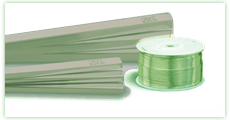1. The Solidus (SOL) and Liquidus (LIQ) temperature values are provided for information only and are not intended to be a requirement in the formulation of the alloys. In the "LIQ" columns, an "e" indicated eutectic alloys and an "mp" indicated the tabulated solidus temperature represents the melting point for the elements. Although efforts have been made to document the correct solidus and liquidus temperatures for each alloy, users of this standard are advised to verify these temperature values before use.
2. Sn95Sb5 has a nominal antimony (Sb) mass percentage of 5.0% and an allowable antimony percent able range of 4.0% to 6.0%.
3. Sn99.9 is included in this standard for use in replenishing tin in wave soldering baths and is NOT suitable for use as a stand-alone solder because of potential performance and reliability problems. |

 This class is specifically developed and mastered for the European users. Also for those who export their products to Europe.
Manufactured to demanding quality standards, diameter capabilities range upto 24 swg. Sn/Ag/Cu (SAC) alloys offer the best balance of properties for the majority of Pb-Free applications. SAC alloys offer better wetting than the binary eutectic Sn/Cu and Sn/Ag. As wetting speed is a key performance requirement for hand soldering, SAC makes the most sense for solid or cored solder wire. For lower temperature rework with the option of controlling the amount of flux, the Bi/Sn/Ag alloy may be the best choice. Solid or non-cored wire along with a liquid flux is the answer when there is too much flux residue associated with rework.
This class is specifically developed and mastered for the European users. Also for those who export their products to Europe.
Manufactured to demanding quality standards, diameter capabilities range upto 24 swg. Sn/Ag/Cu (SAC) alloys offer the best balance of properties for the majority of Pb-Free applications. SAC alloys offer better wetting than the binary eutectic Sn/Cu and Sn/Ag. As wetting speed is a key performance requirement for hand soldering, SAC makes the most sense for solid or cored solder wire. For lower temperature rework with the option of controlling the amount of flux, the Bi/Sn/Ag alloy may be the best choice. Solid or non-cored wire along with a liquid flux is the answer when there is too much flux residue associated with rework. 